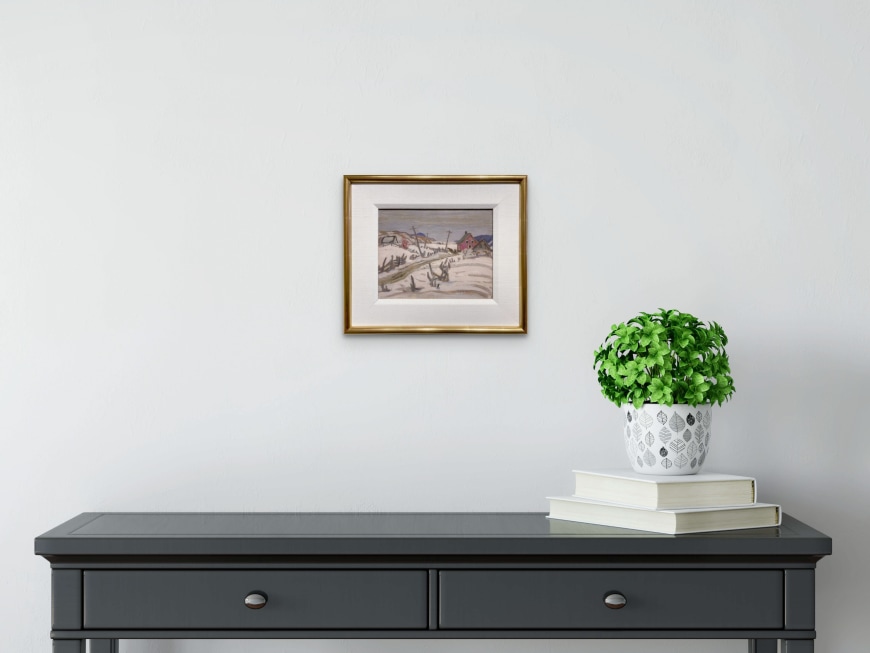-
Artworks
A.Y. JacksonSt-Urbain, Quebec, 1929 (April)1882-1974Double-sided oil on panel8 3/4 x 10 1/2 inThis painting is available to view at our Montreal gallery.
22.2 x 26.7 cm$50,000Inscriptions
signed, 'A.Y. JACKSON' (lower right); titled and dated, 'ST URBAIN- QUE/ APL 1929' (verso, upper right)Provenance
Private collection, Arizona
Heffel Fine Art Auction House, November 25, 2010, Lot 182
Galerie Walter Klinkhoff Inc., Montreal
Private collection, Toronto
In April of 1929, A.Y. Jackson was painting in St-Urbain with his friend and colleague Randolph Hewton as his niece Naomi Jackson Groves wrote in her book, “A.Y.’s Canada” that there are 2 significant trails leading out of Baie St-Paul deep down in Charlevoix County where many of the now iconic artist of the period set out from for their sketching in the Charlevoix region, the luminaries include Fred Hutchison, Clarence Gagnon, Albert Robinson, Edwin Holgate, Fred Hutchison and Randolph Hewton.
Naomi writes that “the other artist trail, along a more ancient road, runs inland, north from Baie St. Paul up the glorious valley of the Riviere du Gouffre (River of the Whirlpool) towards St. Urbain, near which the hospitable log cabin of the Peppers has been located these many years. The trail then branches eastward, past St. Hilarion and Ste. Agnès, to the Malbaie or Murray River, whose double name stems from the two ancient seigneuries, one on its western and one on its eastern bank respectively. Aspects of both grandiose and intimate nature abound along both these routes. The intimate is chiefly in the little villages…” [1]
A.Y. Jackson would occasionally paint on both sides of a wood panel, as he did here. On the reverse of this marvelous painting, is a mostly finished work that Jackson conceived on his trip to western Canada in the summer of 1926. It was then that Jackson traveled to the Skeena River, drawing and sketching the nearby towns and settlements with his colleague, Edwin Holgate, and ethnographer Marius Barbeau. While this settlement is yet to be identified, the figures appear to be First Nations. Jackson’s rural landscapes, more than those of any other member of the Group of Seven, depicted people in their daily lives. Both sides of this work are evidence of Jackson’s particular interest.
In a description of another Jackson painting of April 1929 by Charles C. Hill, he wrote: “The relation of architecture to the landscape was a constant subject in Jackson’s paintings of Charlevoix County. He painted houses and churches in the villages, barns on the rolling hills and small farms in the outlying districts, but always in late winter and early spring. Weather is a constant reference in his letters and especially the qualities of snow. He articulated his observations on the difficulties confronting the artist in “There is Still Snow in Quebec” published in the Ontario College of Art annual, Tangent, in late spring 1929. “The middle of April and winter still holding sway in St. Urbain; but slowly it is getting pried loose. The hills facing south are almost bare, the roads are mud and slush. The snow has all gone off the roofs, piles of field stones are emerging.” [2]
________
Footnotes:
[1] Naomi Jackson Groves, A.Y.’s Canada (Toronto/Vancouver: Clark, Irwin & Co., 1968), 70.
[2] Charles C. Hill, in The Collection of Mitzi and Mel Dobrin, edited by Alan Klinkhoff Gallery (Montreal/Toronto: Alan Klinkhoff Gallery, 2020), 128-129.
1of 2

















